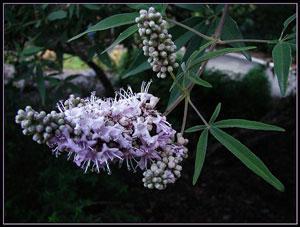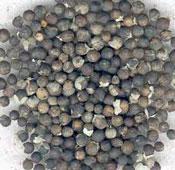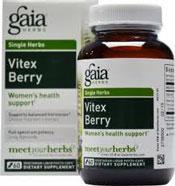
Also known as chaste tree berry, vitex produces beautiful flowers and deep blue berries
Headaches, bloating, moodiness, breast tenderness – if you’re a women you’ve experienced at least one of these symptoms, and chances are it’s been related to PMS, perimenopause or menopause.
Or, perhaps for you it’s acne (or some other skin weirdness), backaches, cramping, sudden cravings for apple fritters (or cheetos), or uncontrollable urges to burst into tears at inopportune moments.
A woman’s hormones can grab a stranglehold on both her emotions and physical well being at any age. But those years known as ‘perimenopause’ can be the most challenging.
At least when we’re younger and cycling regularly we kind of know what to expect: Grumpy and emotional during the week before. Must have chocolate in the house for those first few days. Feeling sexy a week after the period ends….it’s different for each of us, but every woman has their own personal cyclical symptoms.
And then we hit perimenopause and it all starts to get a little crazy on us.
Whoa….wait a second, the grumpiness lasted two weeks and just went away with no period. What the….?
Yeah, welcome to the perimenopausal phase of life. Joyfully lasting a decade or more, hormones gone haywire keep us guessing (and crying) year after year.
The good news is that all of this can be managed (to a degree) with mindful health and lifestyle choices. From the foods we eat, to the activities we engage in – we can gain a modicum of control over an uncontrollable fit of nature.
For me, medicinal herbs are one of my first go-to measures whenever anything gets out of balance. And today I want to introduce one you might have heard of: Vitex.
You may know this popular plant as chaste tree berry – so named for its legendary as an ‘anti-aphrodisiac” by monks during the Middle Ages. It was also called ‘monk’s pepper’, and whether it achieved its purpose in suppressing the sex drives of men of the cloth remains in question.
Some modern research suggests that vitex actually stimulates the female libido. Most experts today don’t claim vitex to have any noticeable action on sex drive.
What it does do for women is enhance certain hormones and inhibit others. Taken regularly this herb has a powerful effect on the endocrine glands.
So whether you’re battling the PMS blues, or – like me – alternating between hot flashes and menstrual cramps, vitex just may provide the relief you crave.
But it’s not a quick fix. Like many herbs, vitex doesn’t act like ibuprofen, providing nearly instant relief of symptoms. This herb has been shown to be most effective as a slow-acting tonic. Vitex (or chaste tree) offers a gentle and indirect normalization of the hormones of the reproductive system.
Most women notice results after taking it daily for two or three months. And then of course you have to keep taking it (for at least a year) to experience continued enjoyment of its effects (AKA relief of those freaky symptoms that plague you!)
Why Is Vitex Up Next For Me?
If you read this blog regularly, you know that I pinned a lot of hope on the plant Maca to relieve my sudden onset of hot flashes and night sweats. I wrote about it a few weeks ago, and in order to tell if it was working or not, I resolved to stick to Maca, and Maca only, for at least two weeks.
And the good news is in! Maca is incredible.
The several-times-a-day hot flashes have subsided, the night sweats are giving me a much-needed break, and I’m even noticing some increased lubrication down there in that crucial area! So – Woot Woot for Maca! I didn’t even have to give up wine – something I was dreading.
Now, it’s totally possible I will be revisited with more hot flashy fun as my menopause progresses, but for now I’m cheering. And drinking those Maca smoothies (or taking the capsules) every single day.
But, now that the dryness and hot and cold episodes have subsided, it’s hello pelvic cramping!
It’s been almost three months since my last moon (an unheard of turn of events for me – but that’s perimonepause!) About a month ago I battled PMS-style cramps for more than two weeks. But instead of my period we moved right on to aforementioned hot flash city.
Now – here it is again. The cramping, the mood swings, all the symptoms of an impending period – except the actual period. Based on my research, I think of all the menopause herbs, vitex might just be the one to bring some semblance of balance here.
I’ve known about this herb for years of course – and recommended it to many women. But somehow I never got on the program myself. I can be my own non-compliant patient that way. I need enough pain to push me into actually following a therapeutic protocol.
Or motivation, or discipline – something.
Now that I’ve read up for this article and refreshed my memory on the many medicinal and magical powers of this little bitter berry, I’ve got my motivation back!
I hadn’t realized till now that the vitex bush is native to the Greek islands where it was considered sacred to the goddess Hera, protecter of married woman & mothers. I wonder if those ancient Greek women sailed through their menopause and barely felt a cramp because of this plant ally growing in their midst?

Dried chaste tree (vitex) berries can be ground into a powder and made into tea, tincture or capsules
I also discovered that for some women vitex works even better for hot flashes than black cohosh – an herb much better known to treat that particular annoyance.
With its myriad of benefits, vitex just jumped up and waved at me, wanting to be picked as my next remedy in this personal menopausal herbs experiment.
An Ally For A Variety Of Symptoms
Vitex promotes the rebalancing of hormone signals between the brain and the ovaries. It increases ratio of progesterone to estrogen, while reducing prolactin - which is one of the reasons why it can be a panacea for PMS.
Some researchers theorize that vitex specifically influences luteinizing hormone (LH) and follicle-stimulating hormone (FSH) – both of which are higher during menopause.
This sends a message to the hypothalamus and pituitary glands to normalize hormone secretion, thus reducing those ‘hormones gone haywire’ crazy-making symptoms.
Because of its ability to increase progesterone levels while decreasing estrogen, vitex is a gentler alternative to try before resorting to pharmaceutical-grade progesterone supplements or creams.
Additionally, this plant is known to relieve chronic menstrual cramping, can reduce or eliminate endometriosis and uterine fibroids, and lessen the severity of breast tenderness and lumps. Stick with vitex and you’re likely to experience relief from bloating and water retention, migraines and depression related to PMS, and hormonal acne. Even skin issues caused by allergies can respond to vitex.
If you’re menopausal and struggling with digestive drama such as constipation, vitex can be your rescuer here as well. For some women the muscular movements of the digestive tract slow during this time, and vitex addresses such hormone-related sluggishness.
As if all that weren’t enough, it’s also reputed to protect against osteporosis and even some reproductive cancers. Used regularly it can restore lubrication to dry vaginal tissues
How To Take Vitex
The medicinal part of the vitex plant –as its other common name implies – is the berry. But this ain’t no sweet and yummy berry, and I won’t be adding it to my morning smoothie. Vitex is as bitter as they come.
And I know myself – if I try to drink the one recommended cup of vitex tea a day I will end up discovering a nearly full cup of forgotten tea, with only a sip or two taken out of it. I could choke down a cup of the cool tea but I think I shall resort to other means.
I’m starting off with some capsules, but that’s going to get expensive so I’ll be making up a big ole’ batch of the tincture with the dried berries. Another alternative would be to make up my own caps with the dried and freshly powdered berries – but that is freaking tedious and I don’t watch enough movies to pass the time while I laboriously make up my own capsules.
Where To Get It & How Much Do You Need

Gaia Herbs makes a high quality vitex capsule
Health food stores carry a variety of vitex supplements from capsules to tincture. And you can purchase the dried berries in bulk from any good herb shop. Since you need to stick with vitex for a while to get results, it’s best to order or buy it in the largest quantity you can afford.
You can order vitex berries by the pound at Moonrise Herbs, or Mountain Rose – or stock up on large bottles of tincture or capsules.
If you’re the green thumb sort, and you have some space in your yard, why not plant a vitex bush or two? Then you can dry you own berries and powder them up for tinctures or capsules. It’s an attractive shrub with large leaves and small black berries. Check your favorite nursery supplier for Vitex agnus-castus.
Once you’ve got your stash of vitex, follow these guidelines for dosage:
Take 20-30 drops (about one full dropperful) of the tincture 1-2 times per day, or 3-6 capsules twice per day. If you’re willing to brave the tea you’ll want to slug down at least one cup each day made with the powdered berries. Use a heaping teaspoon per cup.
If you don’t notice any change in symptoms after a couple of months on your vitex protocol, don’t give up! Increase your dosage to the maximum recommended. Remember this is a slow-acting therapy and, to use an annoying cliché – patience is a virtue!
Vitex plant photo credit: Tatters
